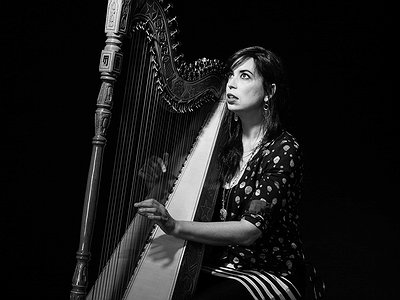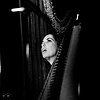Name: Sarah Pagé
Nationality: Canadian
Occupation: Harpist, composer
Current Release: Dose Curves on Backward Music
Recommendations: Check out “Tsubame” for koto quartet by my sensei Chieko Mori.
And for a good read “Do Not Say That We Have Nothing” by Montrealer Madeleine Thien.
If you enjoyed this interview with Sarah Pagé , visit her homepage or bandcamp site for more of her music, videos and everything you ever wanted to know about her.
When did you start writing/producing music - and what or who were your early passions and influences? What what is about music and/or sound that drew you to it?
I started writing music a pretty long way into my career as a musician. I’m not sure if it’s because I come from a classical background, but it took until I was almost 30 to work through some of the pressure I put on myself for a certain kind of complexity in composition. Classical music is so broad and works with such long forms I felt I didn’t have enough ideas to complete work on that level. I did a lot of improvising and arranging of other people’s music in my 20s and after almost a decade of doing that I finally found my own way into writing.
I’ve accepted that I’m more comfortable working with a sound as the seed for a piece than a melody, harmony or rhythm. Now I just find a sound I love and try to follow it as it unfolds. It’s more in keeping with what drew me to music in the first place. Sound has a way of stopping me in my tracks and really connecting me to the present moment. It works on my imagination and suggests different spaces and times while grounding me in reality. Nothing else has that effect on me. It’s totally mysterious and yet immediately tangible.
For most artists, originality is first preceded by a phase of learning and, often, emulating others. What was this like for you? How would you describe your own development as an artist and the transition towards your own voice? What is the the relationship between copying, learning and your own creativity?
I definitely spend a lot of time learning before I create. An absurd amount of time. Partly because I actually enjoy the feeling of learning more than creating. Studying classical and folk music from all over the world gives me the feeling than I’m time travelling and getting to experience different perspectives on music. And there’s no responsibility attached to it. When creating you do have to take responsibility for every sound you put forth and that can feel quite heavy at times. Even so I feel lucky that there are very few harpists who are playing in a way that I want to emulate so I don’t have to tread as carefully around my influences as say a guitarist does.
I do pull a lot from the musicians that surround me and I’m always drawn to sounds that are the furthest from what I know I can access. Trying to sound like a sax, synth or cello is not obvious for a harp but I tend to fall in love with sounds that are foreign to my practice. I think that’s the key to finding your own voice. Playing with unexplored areas and what comes out is a kind of broken telephone passed from one musician to the next but it’s totally unique. When I’m writing I don’t worry too much about being original. Everything I’ve ever heard and all of my influences are swirling around somewhere inside me and they’ll filter their way out in time without me doing anything about it.
What were your main compositional- and production-challenges in the beginning and how have they changed over time?
It really differs from one project to another. Working with a band is different than solo. Working with folk music is different than something more experimental. For Dose Curves the main challenge was trying to find a way to have my harp take on multiple roles to create full arrangements. I have done a lot of ensemble work so I’m used to hearing contrary voices happening simultaneously. Music is conversation for me so as a soloist it’s hard to find a way to capture a dialogue and not just monologue. I don’t like looping because of the way it splits a performer’s energy so I’ve relied on splitting my signal with multiple pickups and running it them through different effects and multiple amps to give me the feeling of being part of an ensemble. All that sound surrounding me on a stage also makes it a bit less lonely!
It is changing these days though. I’ve been learning Japanese music for a few years now and that music is very stark with a lot of emphasis on silence. Silence can make one feel very exposed. Not just the performer but the listener as well. It’s a bold statement that I’d like to explore and could be the opposite direction from what I’ve been working on with the harp until now.
What was your first studio like? How and for what reasons has your set-up evolved over the years and what are currently some of the most important pieces of gear for you?
I’ve always worked at professional studios and have only started building up my home studio in the last couple of years. My first studio experiences were very luckily at my friend Patrick Watson’s place and at the legendary Hotel2Tango studio in Montreal. I learned a bit about recording software and editing from Pat and had the great experience of recording an entire LP to tape with Lhasa deSela at Hotel2Tango.
Apart from my ears, the most important piece of gear I own is my Klark Teknik EQ rack. I have a bunch of great sounding amps, cool pedals and decent pre-amps and mics. I can get a lot of things to sound interesting with a bit of creative re-amping. Being able to use my EQ to clean up mud and bring out the frequencies I’m looking for on any track is vital with a mini studio set up like mine. I can’t do a live show without my Klark Teknik either. The harp is a giant, full-range, resonating chamber/acoustic feedback machine. It can be a real nightmare trying to handle the low mids through a PA and my EQ rack has saved my neck on many occasions.
How do you make use of technology? In terms of the feedback mechanism between technology and creativity, what do humans excel at, what do machines excel at?
Everything is technology. My harp is part wood and part machine and the wood is sculpted to maximize sound projection which is technology. I manipulate its sound and capture the results with technology. It’s amazing to me to see the way art and technology evolve in conjunction with each other. This is the way man has evolved and grown extra limbs for himself. Technology is our imagination and curiosity made into matter.
I think we excel at looking at our surroundings from a macro perspective and we’ve created tools to help us observe micro realities. The data we gather is absorbed and we evaluate its use and determine its place with our choices and preferences. So to go back to the example of EQ, a smart EQ or frequency analyzer can tell me exactly what frequencies are popping out and quickly balance everything so it’s nice and equal. What it can’t tell me is that one of those unruly low mid frequencies is beautiful and that I should see what happens if I boost it instead of cutting it. Some of my favourite art is made by people who use technology in this way. Finding “deficiencies” and giving them value.
Production tools, from instruments to complex software environments, contribute to the compositional process. How does this manifest itself in your work? Can you describe the co-authorship between yourself and your tools?
Right now I feel the pickups, effects pedals and amplifiers that I work with play an enormous role in my compositions. The seed of any piece is usually a sound I’ve never heard before and want to work with. I’ve been playing the harp for 20 years now and although I think as an acoustic instrument its range is endless. When I plug it into a ring modulator it’s pretty much instantly uncharted waters.
The possibility of capturing and magnifying sounds that would be inaudible without pickups and software is pretty incredible too. This year I’ve finally found a way to record just the resonance of the harp strings ringing sympathetically which I’m really excited about. I’m working on a series of pieces for sympathetic resonating strings that could never be heard or performed live. It’s an interesting challenge because I don’t even know what my performance sounds like until I listen back to the recording.
Collaborations can take on many forms. What role do they play in your approach and what are your preferred ways of engaging with other creatives through, for example, file sharing, jamming or just talking about ideas?
I love improvising with other musicians. Particularly live. There are some ideas I’ll bang my head against the wall with at home for weeks and as soon as another musician shows up it will fall into place or take a a left turn and end up somewhere I never could have predicted. I think of other musicians as the most important part of my practice. Even if I go to see a show and I hear something incredible I can’t help but get this burning greed for that sound. I’ll go home and try to figure out what the secret is. Why is any particular sound so affecting? I can never reproduce it but I always find something else that excites me. Music is an incredible vehicle for communicating emotion. Meeting someone in music is always a deeply affecting experience I feel very lucky to be able to share.



